Physical Vapor-Deposited Silver (Ag)-Based Metal-Dielectric Nanocomposites for Thin-Film and Coating Applications
Abstract
:1. Introduction
2. Materials, Methods, and Characterization Techniques
3. Results and Evaluations
3.1. Features and Properties of Ag Thin Layer
3.2. Features and Properties of RF Sputtered SiC Thin Films
3.3. Properties of Ag+ SiC Nanocomposite Layers on Optical Glass Substrates
4. Conclusions
Author Contributions
Funding
Institutional Review Board Statement
Informed Consent Statement
Data Availability Statement
Conflicts of Interest
References
- Nur-E-Alam, M.; Lonsdale, W.; Vasiliev, M.; Alameh, K. Application-Specific Oxide-Based and Metal–Dielectric Thin-Film Materials Prepared by Radio Frequency Magnetron Sputtering. Materials 2019, 12, 3448. [Google Scholar] [CrossRef] [Green Version]
- Alias, R.; Mahmoodian, R.; Abd Shukor, M.H. Development and characterization of a multilayer silver/silver-tantalum oxide thin film coating on stainless steel for biomedical applications. Int. J. Adhes. Adhes. 2019, 92, 89–98. [Google Scholar] [CrossRef]
- Ochirkhuyag, N.; Matsuda, R.; Song, Z.; Nakamura, F.; Endo, T.; Ota, H. Liquid metal-based nanocomposite materials: Fabrication technology and applications. Nanoscale 2021, 13, 2113–2135. [Google Scholar] [CrossRef]
- Vannozzi, L.; Iacovacci, V.; Menciassi, A.; Ricotti, L. Nanocomposite thin films for triggerable drug delivery. Expert Opin. Drug Deliv. 2018, 15, 509–522. [Google Scholar] [CrossRef] [PubMed]
- Jin, W.; Maduraiveeran, G. Recent advances of porous transition metal-based nanomaterials for electrochemical energy conversion and storage applications. Mater. Today Energy 2019, 13, 64–84. [Google Scholar] [CrossRef]
- Lustig, W.P.; Mukherjee, S.; Rudd, N.D.; Desai, A.V.; Li, J.; Ghosh, S.K. Metal–organic frameworks: Functional luminescent and photonic materials for sensing applications. Chem. Soc. Rev. 2017, 46, 3242–3285. [Google Scholar] [CrossRef] [PubMed]
- Paladini, F.; Pollini, M.; Sannino, A.; Ambrosio, L. Metal-Based Antibacterial Substrates for Biomedical Applications. Biomacromolecules 2015, 16, 1873–1885. [Google Scholar] [CrossRef]
- Zhao, Y.; Lunt, R.R. Transparent Luminescent Solar Concentrators for Large-Area Solar Windows Enabled by Massive Stokes-Shift Nanocluster Phosphors. Adv. Energy Mater. 2013, 3, 1143–1148. [Google Scholar] [CrossRef]
- Meinardi, F.; Ehrenberg, S.; Dhamo, L.; Carulli, F.; Mauri, M.; Bruni, F.; Simonutti, R.; Kortshagen, U.; Brovelli, S. Highly efficient luminescent solar concentrators based on earth-abundant indirect-bandgap silicon quantum dots. Nat. Photonics 2017, 11, 177–185. [Google Scholar] [CrossRef]
- Merkx, E.P.J.; ten Kate, O.M.; van der Kolk, E. Rapid optimization of large-scale luminescent solar concentrators: Evaluation for adoption in the built environment. Opt. Express 2017, 25, A547. [Google Scholar] [CrossRef] [Green Version]
- Cocilovo, B.; Hashimura, A.; Tweet, D.J.; Voutsas, T.; Norwood, R.A. Highly transparent light-harvesting window film. Appl. Opt. 2015, 54, 8990. [Google Scholar] [CrossRef] [PubMed]
- Vasiliev, M.; Alghamedi, R.; Nur-E-Alam, M.; Alameh, K. Photonic microstructures for energy-generating clear glass and net-zero energy buildings. Sci. Rep. 2016, 6, 31831. [Google Scholar] [CrossRef]
- Dalapati, G.K.; Kushwaha, A.K.; Sharma, M.; Suresh, V.; Shannigrahi, S.; Zhuk, S.; Masudy-Panah, S. Transparent heat regulating (THR) materials and coatings for energy saving window applications: Impact of materials design, micro-structural, and interface quality on the THR performance. Prog. Mater. Sci. 2018, 95, 42–131. [Google Scholar] [CrossRef]
- Rezaei, S.D.; Shannigrahi, S.; Ramakrishna, S. A review of conventional, advanced, and smart glazing technologies and materials for improving indoor environment. Sol. Energy Mater. Sol. Cells 2017, 159, 26–51. [Google Scholar] [CrossRef]
- Yang, C.; Lunt, R.R. Limits of Visibly Transparent Luminescent Solar Concentrators. Adv. Opt. Mater. 2017, 5, 1600851. [Google Scholar] [CrossRef]
- Vasiliev, M.; Alameh, K.; Nur-E-Alam, M. Spectrally-Selective Energy-Harvesting Solar Windows for Public Infrastructure Applications. Appl. Sci. 2018, 8, 849. [Google Scholar] [CrossRef] [Green Version]
- Mohelnikova, J. Materials for reflective coatings of window glass applications. Constr. Build. Mater. 2009, 23, 1993–1998. [Google Scholar] [CrossRef]
- Vasiliev, M.; Nur-E-Alam, M.; Alameh, K. Highly Stable Thin-Film Multilayers For Thermal Regulation and Energy Savings in Smart Cities. In Proceedings of the 2019 IEEE 16th International Conference on Smart Cities: Improving Quality of Life Using ICT & IoT and AI (HONET-ICT), Charlotte, NC, USA, 6–9 October 2019; pp. 229–231. [Google Scholar]
- Wang, L.; Shen, Z.; Du, G.; Wang, P.; Wang, P. The thermal stability of silver-based high reflectance coatings. Thin Solid Film. 2016, 616, 122–125. [Google Scholar] [CrossRef]
- Bulíř, J. Preparation of nanostructured ultrathin silver layer. J. Nanophotonics 2011, 5, 051511. [Google Scholar] [CrossRef]
- Nur-E-Alam, M.; Rahman, M.M.; Basher, M.K.; Vasiliev, M.; Alameh, K. Optical and Chromaticity Properties of Metal-Dielectric Composite-Based Multilayer Thin-Film Structures Prepared by RF Magnetron Sputtering. Coatings 2020, 10, 251. [Google Scholar] [CrossRef] [Green Version]
- Tavsanoglu, T.; Zayim, E.O.; Agirseven, O.; Yildirim, S.; Yucel, O. Optical, electrical and microstructural properties of SiC thin films deposited by reactive dc magnetron sputtering. Thin Solid Film. 2019, 674, 1–6. [Google Scholar] [CrossRef]
- Todi, R.M.; Sundaram, K.B.; Warren, A.P.; Scammon, K. Investigation of oxygen annealing effects on RF sputter deposited SiC thin films. Solid State Electron. 2006, 50, 1189–1193. [Google Scholar] [CrossRef]
- Eichentopf, I.-M.; Böhm, G.; Arnold, T. Etching mechanisms during plasma jet machining of silicon carbide. Surf. Coat. Technol. 2011, 205, S430–S434. [Google Scholar] [CrossRef]
- Sha, Z.D.; Wu, X.M.; Zhuge, L.J. Structure and photoluminescence properties of SiC films synthesized by the RF-magnetron sputtering technique. Vacuum 2005, 79, 250–254. [Google Scholar] [CrossRef]
- Wang, M.; Diao, X.G.; Huang, A.P.; Chu, P.K.; Wu, Z. Influence of substrate bias on the composition of SiC thin films fabricated by PECVD and underlying mechanism. Surf. Coat. Technol. 2007, 201, 6777–6780. [Google Scholar] [CrossRef]
- Lei, Y.; Yu, Y.; Ren, C.; Zou, S.; Chen, D.; Wong, S.; Wilson, I. Compositional and structural studies of DC magnetron sputtered SiC films on Si(111). Thin Solid Film. 2000, 365, 53–57. [Google Scholar] [CrossRef]
- Lim, D.C.; Ahn, H.S.; Choi, D.J.; Wang, C.H.; Tomokage, H. The field emission properties of silicon carbide whiskers grown by CVD. Surf. Coat. Technol. 2003, 168, 37–42. [Google Scholar] [CrossRef]
- Lattemann, M.; Nold, E.; Ulrich, S.; Leiste, H.; Holleck, H. Investigation and characterisation of silicon nitride and silicon carbide thin films. Surf. Coat. Technol. 2003, 174–175, 365–369. [Google Scholar] [CrossRef]
- Mathur, A.; Pal, D.; Singh, A.; Singh, R.; Zollner, S.; Chattopadhyay, S. Dual ion beam grown silicon carbide thin films: Variation of refractive index and bandgap with film thickness. J. Vac. Sci. Technol. B 2019, 37, 041802. [Google Scholar] [CrossRef]
- Amorim, M.; Savio, R.; Massi, M.; Santiago, H. Applications of SiC-Based Thin Films in Electronic and MEMS Devices. In Physics and Technology of Silicon Carbide Devices; InTech: London, UK, 2012. [Google Scholar]
- Nur-E-Alam, M.; Vasiliev, M.; Alameh, K. Dielectric/metal/dielectric (DMD) multilayers: Growth and stability of ultra-thin metal layers for transparent heat regulation (THR). In Energy Saving Coating Materials; Elsevier: Amsterdam, The Netherlands, 2020; pp. 83–112. [Google Scholar]
- Nikolajsen, T.; Leosson, K.; Salakhutdinov, I.; Bozhevolnyi, S.I. Polymer-based surface-plasmon-polariton stripe waveguides at telecommunication wavelengths. Appl. Phys. Lett. 2003, 82, 668–670. [Google Scholar] [CrossRef]
- Chen, J.; Li, Z.; Yue, S.; Gong, Q. Hybrid long-range surface plasmon-polariton modes with tight field confinement guided by asymmetrical waveguides. Opt. Express 2009, 17, 23603. [Google Scholar] [CrossRef] [PubMed]
- Nagaraj; Krokhin, A.A. Long-range surface plasmons in dielectric-metal-dielectric structure with highly anisotropic substrates. Phys. Rev. B 2010, 81, 085426. [Google Scholar] [CrossRef] [Green Version]
- Marini, A.; Skryabin, D.V.; Malomed, B. Stable spatial plasmon solitons in a dielectric-metal-dielectric geometry with gain and loss. Opt. Express 2011, 19, 6616. [Google Scholar] [CrossRef]
- Yan, J.-Y.; Li, L.; Xiao, J. Ring-like solitons in plasmonic fiber waveguides composed of metal-dielectric multilayers. Opt. Express 2012, 20, 1945. [Google Scholar] [CrossRef] [PubMed] [Green Version]
- Carton, O.; Ghaymouni, J.; Lejeune, M.; Zeinert, A. Optical Characterization of Porous Sputtered Silver Thin Films. J. Spectrosc. 2013, 2013, 1–6. [Google Scholar] [CrossRef]
- Palik, E. Handbook of Optical Constants of Solids, 1st ed.; Elsevier: Amsterdam, The Netherlands, 1991; Available online: https://www.elsevier.com/books/handbook-of-optical-constants-of-solids/palik/978-0-08-055630-7 (accessed on 25 June 2021).
- GenIndex. Available online: http://www.luxpop.com/ (accessed on 25 June 2021).
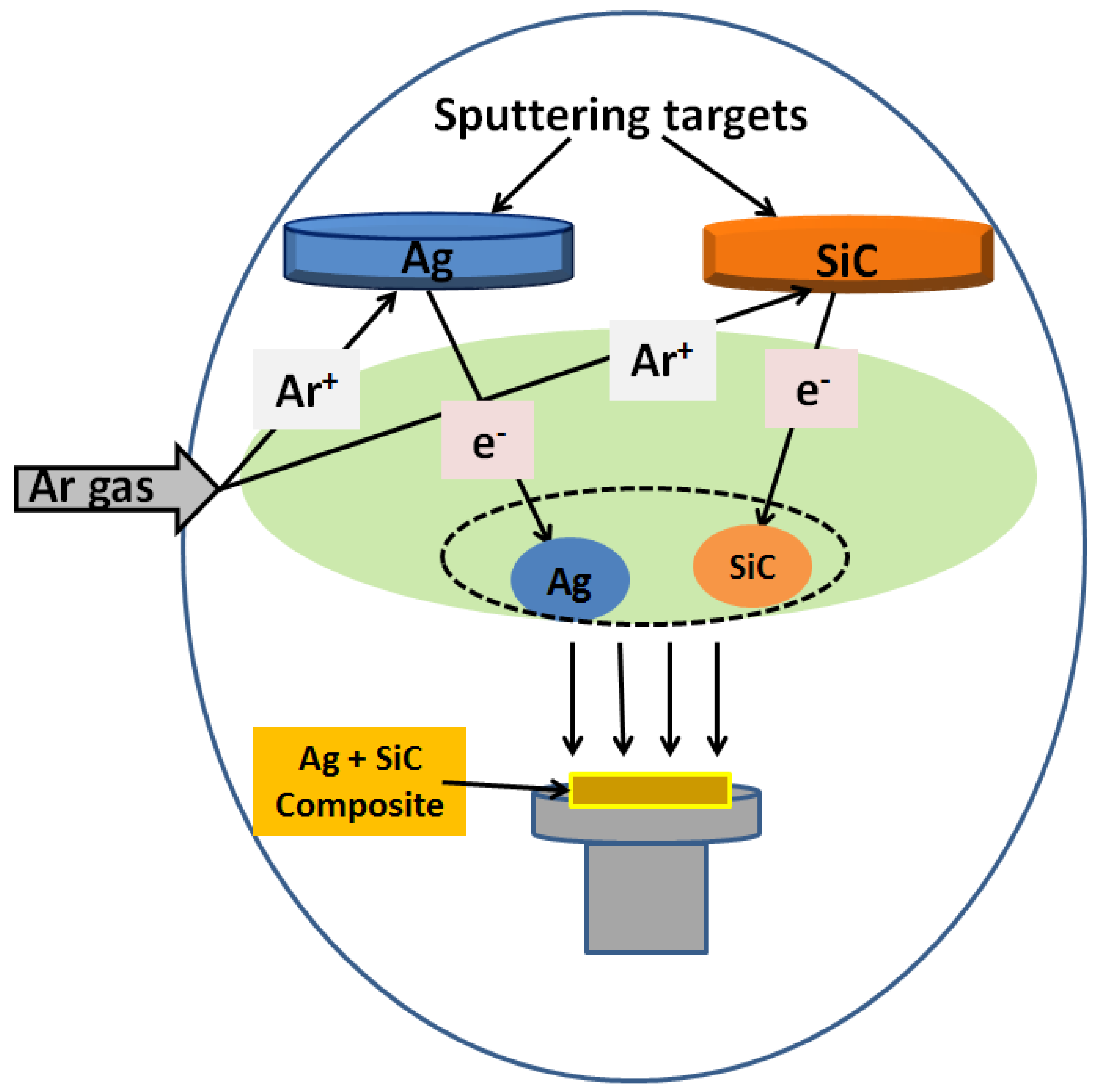
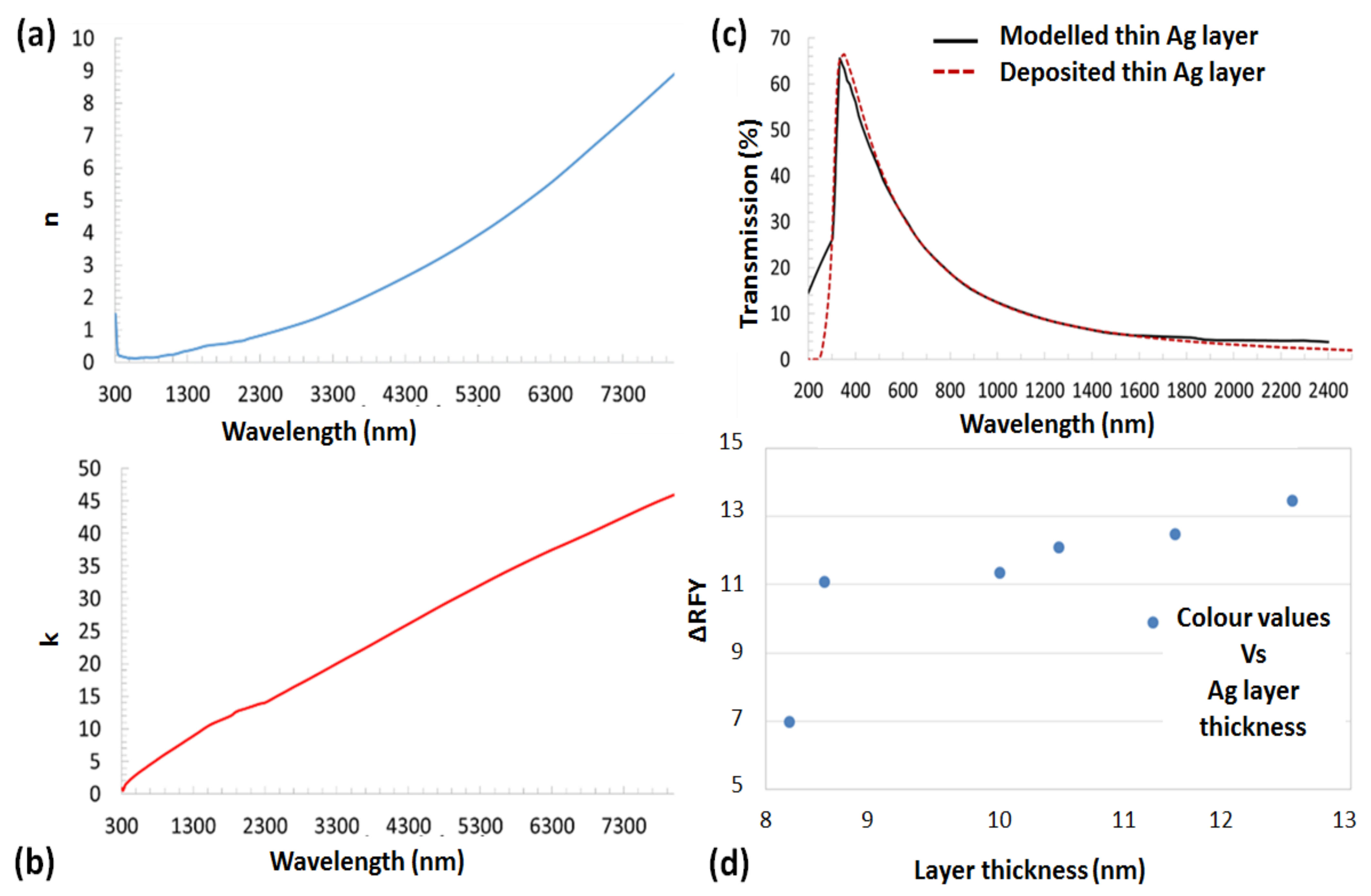
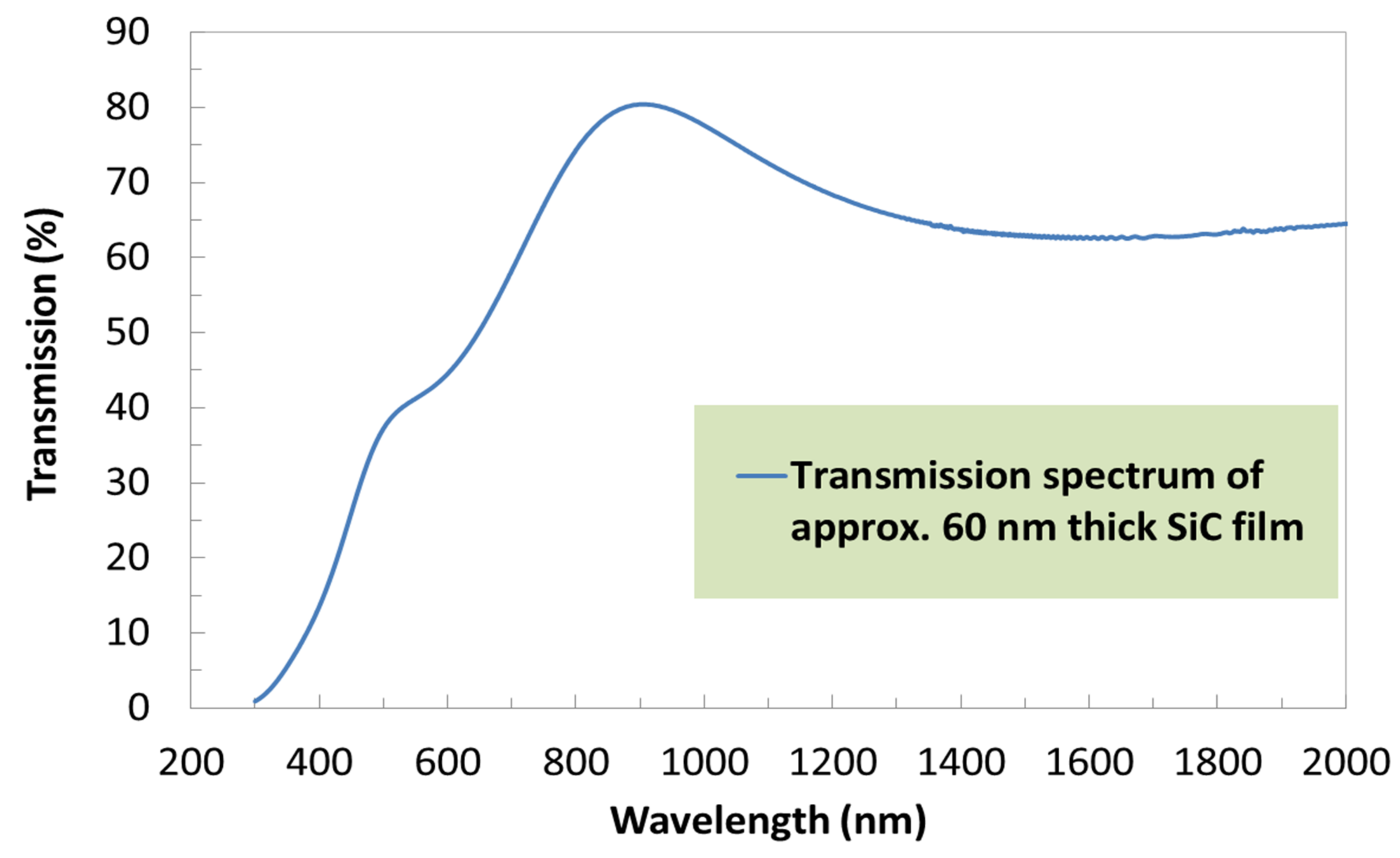
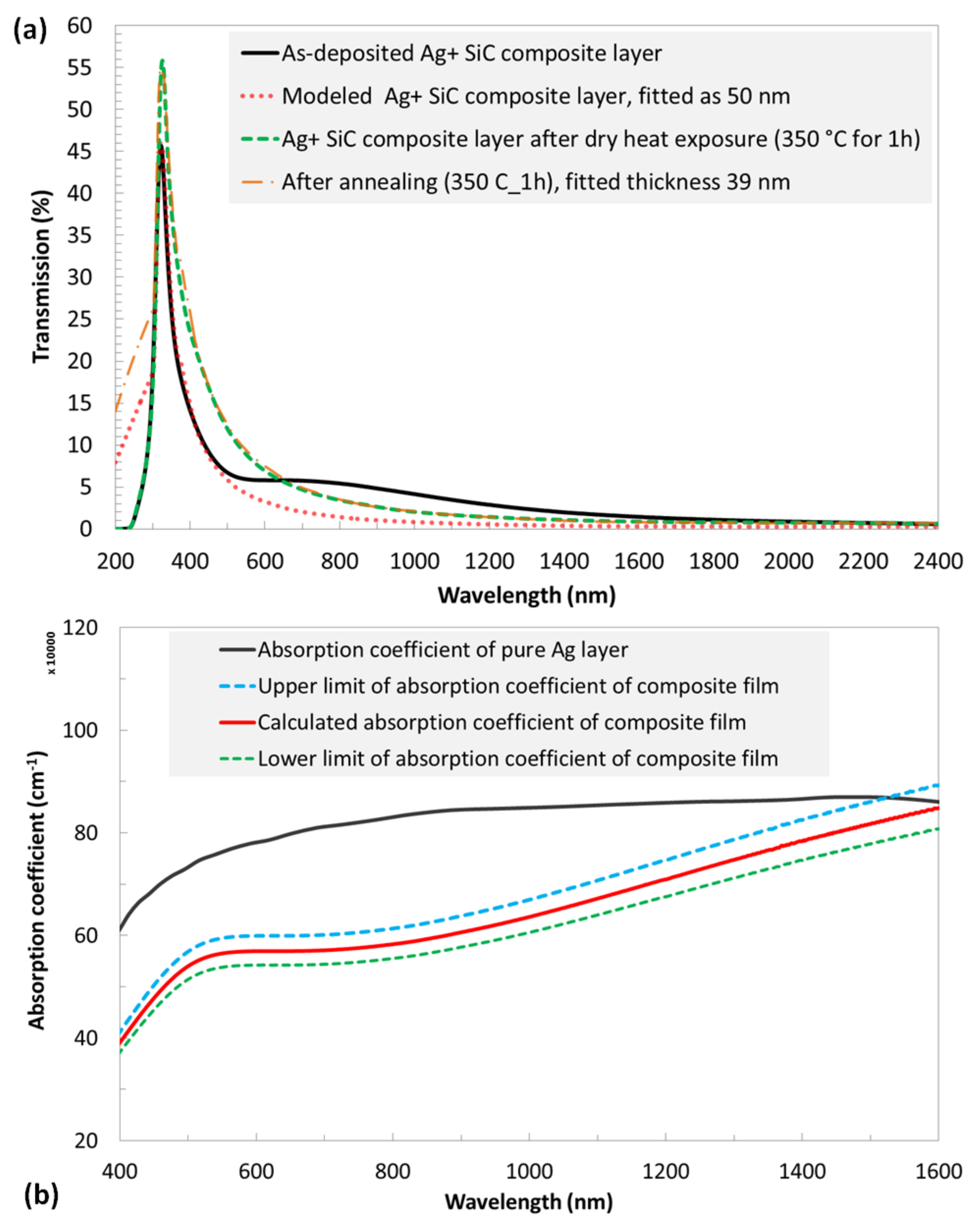
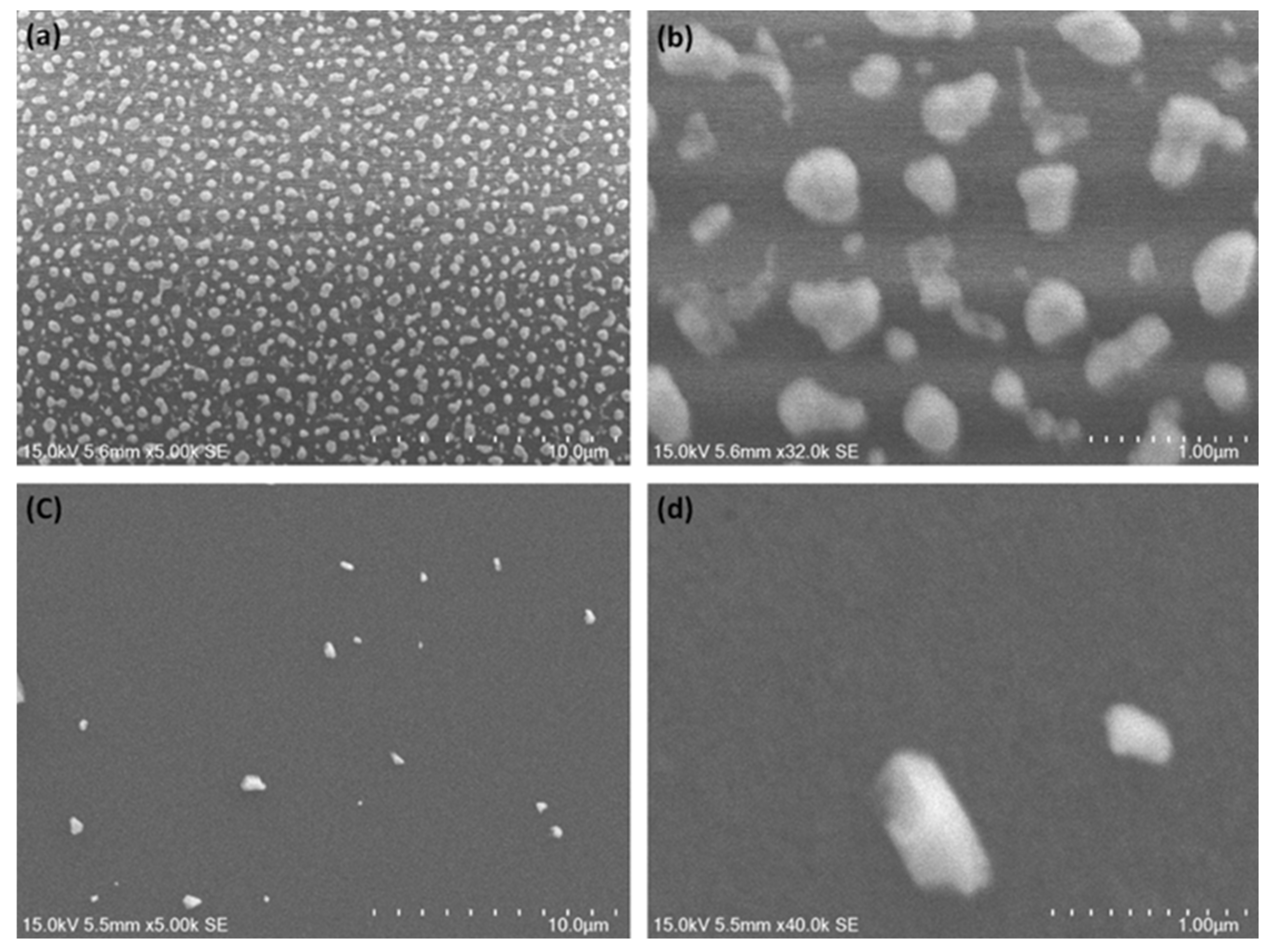
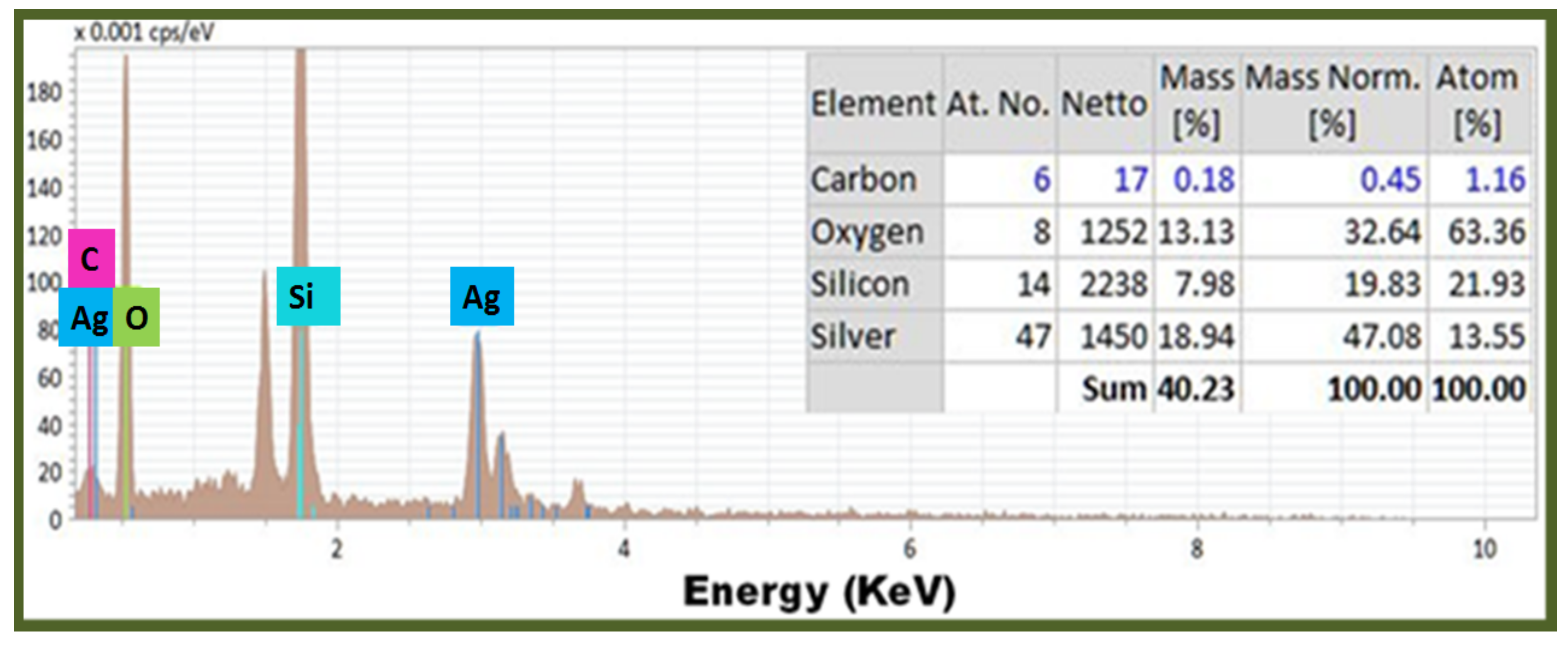
| Process Parameters | Values and Comments |
|---|---|
| Sputtering target stoichiometry | Ag, and SiC |
| Target sourcing | AJA International Inc. 809 Country Way North Scituate, Massachusetts, MA 02066, United States and Zhongnuo Advanced Material Technology Co., Ltd., Beijing, China |
| Base pressure (Torr) | 4–5 × 10−6 |
| Argon (Ar) pressure | ≈2 mTorr |
| RF power densities | 54–64 W for Ag target and 110–120 W for SiC target |
| Substrate stage temperature (°C) | Room Temperature (21–23 °C) |
| Substrate stage rotation rate | 16–16.5 (rpm) |
| Target to substrate stage distance | 18 cm |
| Dry heat treatment | 200 ~ 450 °C for an hour |
Publisher’s Note: MDPI stays neutral with regard to jurisdictional claims in published maps and institutional affiliations. |
© 2021 by the authors. Licensee MDPI, Basel, Switzerland. This article is an open access article distributed under the terms and conditions of the Creative Commons Attribution (CC BY) license (https://creativecommons.org/licenses/by/4.0/).
Share and Cite
Nur-E-Alam, M.; Basher, M.K.; Vasiliev, M.; Das, N. Physical Vapor-Deposited Silver (Ag)-Based Metal-Dielectric Nanocomposites for Thin-Film and Coating Applications. Appl. Sci. 2021, 11, 6746. https://doi.org/10.3390/app11156746
Nur-E-Alam M, Basher MK, Vasiliev M, Das N. Physical Vapor-Deposited Silver (Ag)-Based Metal-Dielectric Nanocomposites for Thin-Film and Coating Applications. Applied Sciences. 2021; 11(15):6746. https://doi.org/10.3390/app11156746
Chicago/Turabian StyleNur-E-Alam, Mohammad, Mohammad Khairul Basher, Mikhail Vasiliev, and Narottam Das. 2021. "Physical Vapor-Deposited Silver (Ag)-Based Metal-Dielectric Nanocomposites for Thin-Film and Coating Applications" Applied Sciences 11, no. 15: 6746. https://doi.org/10.3390/app11156746
APA StyleNur-E-Alam, M., Basher, M. K., Vasiliev, M., & Das, N. (2021). Physical Vapor-Deposited Silver (Ag)-Based Metal-Dielectric Nanocomposites for Thin-Film and Coating Applications. Applied Sciences, 11(15), 6746. https://doi.org/10.3390/app11156746









